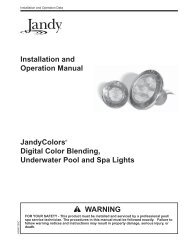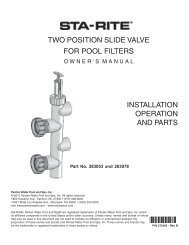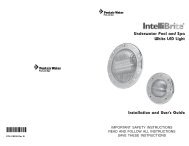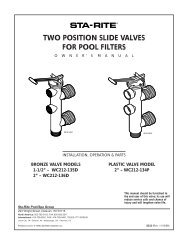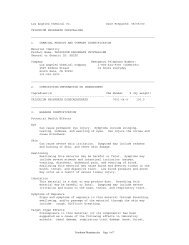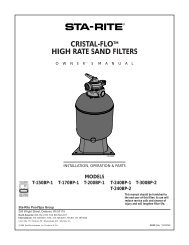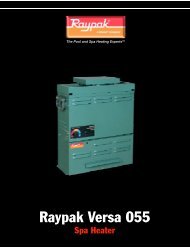Page 46<strong>LXi</strong> Pool/Spa Heater Installation <strong>and</strong> Operation ManualThis can be done by measuring the voltage b<strong>et</strong>weenthe wires of the three-pin connector on the powersupply circuit board. These points are designated astest points D, E, <strong>and</strong> F on Figure 37. The voltagesmeasured b<strong>et</strong>ween any two (2) of these three (3) pointswill be d<strong>et</strong>ermined by the voltage supplied to the transformer.See Table 13 for expected voltages.If the voltages measured do not fall within thelimits shown in Table 13, then there is a problem withthe power supply circuit board <strong>and</strong> the board must bereplaced.MEASUREBETWEENTHESE POINTSTable 12. Supply Voltage MeasurementsEXPECTEDVOLTAGE WITH240V SUPPLYEXPECTEDVOLTAGE WITH120V SUPPLYA <strong>and</strong> B 102 - 132 Volts 0A <strong>and</strong> C 102 - 132 Volts 102 - 132 VoltsB <strong>and</strong> C 204 - 264 Volts 102 - 132 Volts1. Point A is the ground connection on the heater.2. Point B is the location at which the red power leadenters the power circuit board.3. Point C is the location at which the black power leadenters the power circuit board.Table 13. Voltage Supplied To TransformerMEASUREBETWEEN THESEPOINTSEXPECTEDVOLTAGE WITH240V SUPPLYEXPECTEDVOLTAGE WITH120V SUPPLYD <strong>and</strong> E 102 - 132 Volts 102 - 132 VoltsD <strong>and</strong> F 204 - 164 Volts N/AE <strong>and</strong> F 102 - 132 Volts 01. Point D is the location at which the white wire entersthe 3 pin connector.2. Point E is the location at which the black wire entersthe 3 pin connector.3. Point F is the location at which the blue wire enters the3 pin connector.10.5.2 ControllerThe controller must be <strong>operation</strong>al in order tocheck the control circuits of the heater.10.5.3 Control Circuit TroubleshootingThe heater controls are arranged in several 24V60Hz circuits with some operating <strong>and</strong> saf<strong>et</strong>y controlsarranged in series circuits.Troubleshooting is done by probing for voltageb<strong>et</strong>ween the common <strong>and</strong> various points in the circuitto d<strong>et</strong>ermine which component is preventing <strong>operation</strong>.Check points are indicated on Figure 37. Theblack lead of the m<strong>et</strong>er should be attached to the commontap on the secondary side of the transformer <strong>and</strong>may be left there throughout most of the procedure.The recommended procedure steps through eachcircuit in a sequential way, <strong>and</strong> each section assumesthat components from all previous sections have beentested <strong>and</strong> are <strong>operation</strong>al. However, verifying voltageat any of the numbered points in that circuit confirmsthat all prior components of the circuit are <strong>operation</strong>al.10.5.3.1 TransformerS<strong>et</strong> the voltm<strong>et</strong>er to measure AC voltage. Attachthe black lead of the voltm<strong>et</strong>er to the terminal on thesecondary side of the transformer with a yellow wireattached to it (common). This is test point 1 onFigure 35. Touch the free lead of the voltm<strong>et</strong>er to th<strong>et</strong>erminal on the secondary side of the transformer witha red wire attached to it (24V tap), test point 2. Thevoltm<strong>et</strong>er should read b<strong>et</strong>ween 20-28 Volts AC.10.5.3.2 FuseLeave the black voltm<strong>et</strong>er lead in place at testpoint 1. Touch the free lead of the voltm<strong>et</strong>er to testpoint 3, which is on the Power Interface Board wher<strong>et</strong>he red wire from the transformer enters the end of theconnector. You will need to push the voltm<strong>et</strong>er leadinto the back of the connector along side of the wirepin. The m<strong>et</strong>er should read 20-28 Volts AC.If there is no voltage, the fuse has failed. Inspectthe rest of the wiring, especially the saf<strong>et</strong>y circuit, tobe sure that there is no “short” such as contact of aterminal with the heater chassis or another terminalwhich may have caused the fuse to fail.Correct any such condition <strong>and</strong> replace the fuse.Use only a 2 amp, 1¼" long x ¼" diam<strong>et</strong>er, fast-acting,glass-tube type fuse.10.5.3.3 Water Pressure SwitchStart by checking the voltage at the two (2) legsof this circuit on the controller. (See test points 4 <strong>and</strong> 5in Figure 35. Check the voltage at test point 4, wher<strong>et</strong>he viol<strong>et</strong> wire from the pressure switch enters the twopinconnector on the controller.If there is not 20-28 Volts AC nominal at thispoint, either the controller or the two-pin wire harnessis faulty <strong>and</strong> must be replaced.If 20-28 Volts AC nominal is d<strong>et</strong>ected at testpoint 4, then move the red lead of the m<strong>et</strong>er to testpoint 5 where the gray wire from the Pressure Switchenters the two-pin connector. If 20-28 Volts AC nominalis d<strong>et</strong>ected at this point, the devices in this circuitare closed <strong>and</strong> the circuit is working properly.If there is no voltage the pressure switch contactsare open. This is almost always due to a water flowdeficiency, the most common one being a blockedwater filter or defective pump. However, som<strong>et</strong>imesit is due to blockage of the copper siphon loop tube ormis-adjustment of the switch.Investigate thoroughly, referring to Section 7.7,Adjustment of Pressure Switch. If there is no problemwith the pool system or pressure switch adjustment,replace the pressure switch.
<strong>LXi</strong> Pool/Spa Heater Installation <strong>and</strong> Operation Manual Page 4710.5.3.4 Fusible LinkTo check the fusible link/air louver/field interlockcircuit, place the red lead at test point 6. If there is not20-28 Volts AC nominal, either the controller or th<strong>et</strong>wo-pin wire harness is faulty, or the water pressureswitch is open.If 20-28 Volts AC nominal is d<strong>et</strong>ected at testpoint 6, then move the red lead of the m<strong>et</strong>er to testpoint 7. If 28 Volts AC nominal is d<strong>et</strong>ected, the circuitis closed <strong>and</strong> working correctly.If the proper voltage is not d<strong>et</strong>ected, either thefusible link or field interlock has opened, or the wireharness is faulty. Failure of the fusible link must beinvestigated further to identify the cause of the failure.10.5.3.5 Temperature Limit SwitchesCircuitSince the limit switches are not easily accessible,the voltage can be checked at the two legs of the circuitat the controller. See test points 8 <strong>and</strong> 9 inFigure 37.Check the voltage at test point 8. If there is not20-28 Volts AC nominal at this point, either the controlleror the two-pin wire harness is faulty, or one ofthe two saf<strong>et</strong>ies (water pressure or fuselink) before it isopen.If 20-28 Volts AC nominal is d<strong>et</strong>ected at thispoint, then move the red lead of the m<strong>et</strong>er to test point9, where the black wire from the 130° limit entersthe two-pin connector. If 20-28 Volts AC nominal isd<strong>et</strong>ected at this point, the devices in this circuit areclosed <strong>and</strong> the circuit is working properly.If there is no voltage, one of the limit switches isopen. This is normally due to excessive water temperature,which should be thoroughly investigated beforereplacement of limit switches. Excessive water temperaturemay be caused by low water flow. Water flowdeficiency may be due to obvious problems such as adefective pump or blocked water filter.Alternatively, excessive water temperature maybe due to over-firing, or to a problem with the waterpiping or the heater's internal bypass control. Overfiringmight be a result of an incorrect gas orifice orsupply of propane gas to a heater intended for naturalgas.If there are no such fundamental problems, identifywhich of the switches is open. Limit switch accessis through the limit switch plugs on the side of theheater to which water pipes are connected. Remove thelimit switch plugs from the bottom of the header <strong>and</strong>gently remove the switches from the wells.Note that the limit switches have different trippoints, <strong>and</strong> it is important that replacements are correct.The 150°F switch has a red dot on the top of theswitch, <strong>and</strong> must be installed in the lower well in theheader. The 130°F switch has no dot <strong>and</strong> must be installedin the upper well in the outl<strong>et</strong> of the header.Move the red m<strong>et</strong>er lead to the terminal connectionon the 150° switch that is connected back to thecontroller. The voltm<strong>et</strong>er should read 20-28 Volts ACnominal. No voltage here means that the two-pin wireharness is bad <strong>and</strong> should be replaced.If voltage is d<strong>et</strong>ected at this point, move the leadto the other terminal of the switch. If the voltm<strong>et</strong>erdoes not show voltage, then the 150° limit is bad <strong>and</strong>should be replaced.If the m<strong>et</strong>er reads 20-28 Volts AC nominal, mov<strong>et</strong>he lead to the terminal of the 130° limit that is connectedto the wire that jumps b<strong>et</strong>ween the two limitswitches. No voltage here means that the wire assemblyis bad <strong>and</strong> needs to be replaced. 20-28 Volts ACnominal shows that the wire b<strong>et</strong>ween the two limits ismaking a good connection.Now move the lead to the other connectionterminal on the 130° limit. No voltage at this pointindicates that the limit switch has failed <strong>and</strong> needs tobe replaced. Voltage here would show that the limit isgood <strong>and</strong> that the two-pin wire harness may have a badconnection. Replace the wire harness if necessary.10.5.3.6 Blower Pressure Switch CircuitThe blower must be operating during the test procedurefor the blower pressure switch. Start by checkingthe voltage b<strong>et</strong>ween test point 1 <strong>and</strong> the common<strong>and</strong> normally open contacts of the air flow switch.Leaving the black lead of the m<strong>et</strong>er on test point1, check the voltage at test point 11. If there is not20-28 Volts AC at this point, the eight-pin wire harnessis faulty <strong>and</strong> must be replaced. If 20-28 Volts AC is d<strong>et</strong>ectedat this point, then move the red lead of the m<strong>et</strong>erto the Air Flow Switch NO contact. If 20-28 Volts ACis d<strong>et</strong>ected at this point, the device in this circuit isclosed <strong>and</strong> the circuit is working properly.If there is not 20-28 Volts AC at the Air FlowSwitch NO contact, the pressure switch contacts areopen. This is usually due to a blower speed problemor a problem with the air pressure tube connectionb<strong>et</strong>ween the blower housing <strong>and</strong> the switch.Be sure that the blower is on <strong>and</strong> that it is workingproperly. Check that the gray flexible tube b<strong>et</strong>weenthe blower pressure switch <strong>and</strong> the blower housing isconnected at both ends <strong>and</strong> has no holes or splits. Replac<strong>et</strong>he tube if necessary. If there is no problem withthe blower or the tube, check for blockages in the vent,flue or heat exchanger that would prevent air flow. Ifno blockages are found, replace the pressure switch.If the Air Flow Switch NO contact shows 20-28Volts AC <strong>and</strong> the ignition control shows an air flowfault, then there is a bad connection b<strong>et</strong>ween theblower pressure switch <strong>and</strong> the ignition control, or theignition control is faulty.Check for voltage at test point 12 on the ignitioncontrol. If no voltage is present, then the connectionis bad, replace the wire harness. If 20-28 Volts AC ispresent, replace the ignition control.




